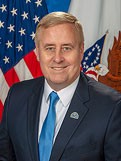Sep 29
2020
An Innovative Solution To Support Expanded Telehealth Capability
By James P. Gfrerer, chief information officer, U.S. Department of Veterans Affairs.

An established leader in telehealth technology, VA has been using real-time virtual video medical appointments since 2002 to connect veterans with VA clinicians for the care they need, when they need it. VA’s telehealth program has been an essential element in serving our nation’s veterans, making it easier for them to receive care and convey vital information to their medical providers.
Today, the expansion of VA telehealth and telemedicine technologies is a key element of VA’s COVID-19 response efforts. VA Video Connect virtual appointments and other telehealth technologies are playing an important role in flattening the pandemic growth curve by providing patients quick, easy, and effective access to healthcare professionals.
VA Video Connect allows VA to treat non-COVID-19 patients (and those experiencing mild symptoms) in the comfort of their own home while limiting unnecessary in-person exposure and keeping beds open in VA medical centers for those most in need.
Nationwide, OIT is deploying more than 50,000 telehealth kits—each containing a laptop, docking station, mouse, keyboard, webcam, headset, and two monitors—to enable VHA clinicians to connect remotely with patients. VA’s strong foundational investments ivn telehealth over the past decade positioned OIT to rapidly expand the delivery of virtual care to support eterans during the COVID-19 pandemic.
Since the outbreak, OIT has supported a 1,500% surge in veteran video visits outside of a VA facility—from approximately 41k total monthly video visits in January to more than 659,000 in July. To stay ahead of the growing demand, OIT tripled telehealth visit concurrent call capacity from 3k in February to more than 9k.
By upgrading the VA Video Connect system’s on-premises hardware and expanding the video conferencing system to the cloud, the Department further increased this capacity to handle more than 15k concurrent sessions (nearly five times the pre-COVID capacity). In July alone, OIT’s expanded VA Video Connect capacity helped more than 371,000 unique veteran patients limit exposure to and spread of COVID-19.
This is 12.5 times the number of veterans who used VA Video Connect in February (29,706).
Since January 2020, the expanded VA Video Connect system has helped veterans conduct more than 2.8 million telehealth appointments from their own homes or another non-VA site. OIT continues to grow telehealth support to meet VHA’s anticipated total telehealth visits to home for fiscal year (FY) 2020—3.8 million (compared to just under 295,000 visits in FY2019).
OIT is also helping VA expand its use of tele-critical care capabilities. Tele-critical care carts allow all intensive care units (ICUs) in a network to have access to an intensivist-led care team and gives them 24/7 access to specialist expertise. The carts allow the tele-critical care team members to assess patients and support their care.
OIT configured dynamic port security for a total of 139 priority tele-critical care sites (previously known as tele-ICU sites) ahead of schedule—and completed the initial 82 VHA priority facilities in mid-June. This capability allows health care workers to move the carts from room to room without needing IT intervention and ensures clinicians can continue to provide seamless care to Veterans.
Deploying and connecting more than 250 carts, VA surpassed its original goal to have at least one tele-critical cart for every 10 ICU beds—achieving a 1:8 cart-to bed ratio (with 1,800 total ICU beds in VA)—and enabled future expansion of the tele-critical care cart functionality.
VA’s recent telehealth successes will continue beyond the COVID-19 pandemic, so that VA can continue to deliver on Secretary Wilkie’s prime directive—delivering exceptional customer service to our Veterans. Other federal agencies have taken notice and expressed interest in leveraging VA’s lessons learned with its massive expansion of telehealth solutions, and VA is working with the United States Coast Guard and the Department of Defense’s Defense Health Agency to help enhance their own video conferencing and telehealth capabilities.